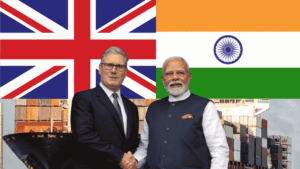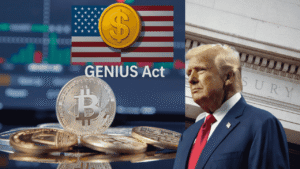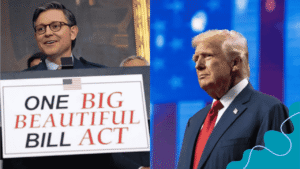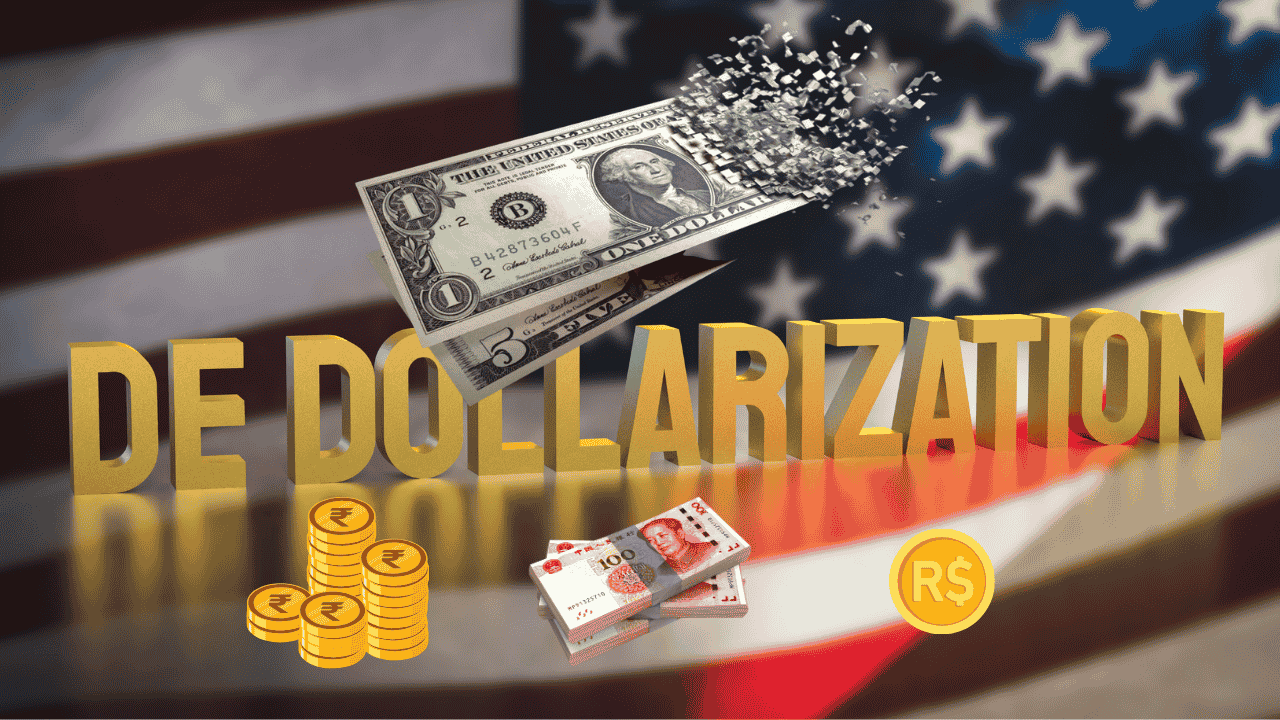|

Reviewd by: Dileep K Nair
Senior Editor & Expert Reviewer
Washington is once again testing ther esilience of the global trading system. The Trump administration’s latest tariff wave has widened cracks with partners once counted as reliable allies. India is facing a 50% tariff hike tied to its Russian oil imports. Brazil is scrambling to soften the blow to its exporters.
Mexico has been left in limbo with tariff threats paused but not lifted. At the same time, the BRICS bloc is getting louder in its push for alternatives to the dollar, from common payment rails to talk of a shared unit of account.
Key Takeaways
- Despite tariff disputes and BRICS currency debates, the dollar still makes up about 58% of global foreign exchange reserves, according to IMF data.
- U.S. Treasury markets, rule of law and liquidity remain the dollar’s strongest anchors.
- Tariffs and strained alliances may encourage local currency settlements in niche markets but do not yet represent systemic change.
- BRICS payment experiments face hurdles in governance and liquidity, limiting immediate adoption.
- Any shift away from the dollar will be incremental and slow, not abrupt.
The dollar remains the world’s most used currency, but the convergence of tariff aggression, strained alliances and louder de-dollarization narratives is raising a pressing question for investors and policymakers alike: are these just passing headlines, or do they point to a more durable challenge to the U.S. currency’s dominance?
Table of Contents
The Recent Flashpoints: Signals to Watch
India
The sharpest clash has been with India. Washington raised tariffs on a wide set of Indian goods, moving rates from 25% to 50%, citing New Delhi’s decision to maintain discounted Russian oil purchases. According to the Washington Post, U.S.–India ties are now described as “at their worst” in decades, despite the fact that energy trade between the two continues.
Indian officials argue the measures are discriminatory since several Western allies also continue oil trade with Russia in different forms. In a televised statement, India’s Commerce Ministry warned that the higher tariffs would hurt both Indian producers and American buyers by raising costs across supply chains.
Brazil
In Brazil, the response has been more cautious but no less strained. President Luiz Inácio Lula da Silva announced a 30 billion reais ($5.5 billion) emergency aid package to help farmers and manufacturers cope with the tariff shock. As reported by Reuters, Lula said Brazil would not rush into retaliatory tariffs, preferring diplomacy and domestic support measures.
Agricultural exporters in particular, already under pressure from tighter credit and weaker global demand, are lobbying for more targeted support.
China and Mexico
The picture is less clear with China and Mexico. In Beijing, officials have so far avoided retaliation but are bracing for possible U.S. tariffs on energy and technology related imports. Firms are increasingly hedging contracts and exploring settlement in yuan to shield against future U.S. actions.
Mexico, meanwhile, has seen negotiations stalled after tariff threats were announced and then paused, creating uncertainty for automotive and electronics suppliers that rely heavily on cross border trade. Some manufacturers are already seeking to diversify supply chains toward Central America as a precaution.
Kenneth Rogoff, Former IMF Chief Economist: “The erosion of the dollar, which I argue started a decade ago, is accelerating due to U.S. trade policies and erratic decision-making, with countries like China pushing for yuan-based trade despite their own economic challenges.”
New Geopolitical Moment: The Trump–Putin Alaska Summit
The summit between Donald Trump and Vladimir Putin in Anchorage, Alaska, drew headlines worldwide but left markets uncertain about its real significance. The meeting, held against the backdrop of Russia’s continued war in Ukraine, was billed as a test of whether
Washington and Moscow could find common ground. Instead, the talks ended without agreement. According to The New York Times, both sides described the discussions as “frank,” but no breakthroughs were achieved on sanctions or military de-escalation.
Market Reaction
Currency markets were quick to register the political theater. The ruble slid nearly 1% in the hours after the summit, while the U.S. dollar gained about 0.5% against it. The move looks modest but symbolic, reflecting the sensitivity of foreign exchange markets to high level diplomacy, even when substance is limited.
Energy stocks in the U.S. saw mild gains on the absence of new sanctions, while European utilities slipped on fears of prolonged instability in energy supplies.
Symbolism vs. Substance
For many investors, the summit reinforced the distinction between geopolitical headlines and macroeconomic fundamentals. The lack of concrete policy outcomes meant that market players quickly shifted their focus back to U.S. inflation data and Federal Reserve guidance. Traders viewed Fed policy expectations as far more consequential for the dollar’s trajectory than the optics of the Alaska meeting.
Inflation Still in Focus
The episode illustrates how geopolitics can trigger short term volatility but rarely alters structural currency trends without clear economic shifts. The stronger driver remains U.S. inflation and the Fed’s stance. Chair Jerome Powell reiterated after the July meeting that the Fed remains “data dependent,” underscoring that monetary policy, not geopolitics, is the anchor of dollar strength.
“Central banks are diversifying where they can. Interest is growing in gold, the euro and yuan, but expectations are for structural changes to be slow and deliberate.”
— OMFIF in its latest reserve currency report
BRICS Currency and De-Dollarization: Separating Narrative from Capacity
The summit headlines were followed closely by renewed discussion of BRICS plans to reduce reliance on the dollar. In recent months, leaders from Brazil, Russia, India, China and South Africa have amplified calls for new payment mechanisms. Discussions have centered on a shared settlement unit or blockchain based payment rails.
The rhetoric is clear: reduce exposure to U.S. sanctions and tariffs by trading in alternative structures.
The Scale of the Challenge
Yet the gap between ambition and execution remains significant. Analysts at the Peterson Institute for International Economics note that governance, liquidity and trust are major barriers. No BRICS member has the institutional framework or debt markets deep enough to provide the scale of safe assets required to underpin a global reserve.
Early Steps, Modest Impact
Some practical experiments are underway. India and the UAE recently completed test settlements in rupees and dirhams for oil trades, while Russia and China are expanding ruble-yuan settlement platforms. But as Financial Times reported, these remain niche transactions relative to the trillions of dollars handled daily in global trade and capital markets.
Narrative vs. Reality
What the BRICS project underscores is less about replacing the dollar outright and more about creating options. Emerging markets facing tariff or sanction risk want alternatives, even if limited in scope. For now, the dollar remains central, but the louder the conversation grows, the more investors will monitor incremental shifts. The risk for Washington is not immediate displacement, but a slow chipping away at the edges of dollar use over time.
A recent OMFIF survey shows around 40% of central banks plan to increase gold holdings over the next decade, with only modest expected declines in the dollar’s share, projected to fall from 58% today to around 52% by 2035 (source: Reuters).
What the data say about the dollar today
Amid talk of de-dollarization, it helps to anchor the discussion in facts. A July FEDS Notes shows that the U.S. dollar still accounts for around 58% of global central bank reserves. While that figure is down modestly from peaks of over 70% two decades ago, the dollar’s share remains more than double that of the euro, which is the second most held currency.
On the U.S. side, the Federal Reserve has highlighted the dollar’s centrality in cross border payments and trade invoicing. According to a recent Fed analysis, nearly half of all cross border loans and international debt securities are denominated in dollars, while a large share of world trade, including transactions that do not involve the U.S. directly, is still priced in USD.
Taken together, these figures provide a counterweight to speculative headlines about imminent collapse. The reality is that while cracks may be forming at the margins, the dollar remains the backbone of the global financial system. Its liquidity, scale and network effects are unmatched and the data shows no abrupt decline in its usage.
How tariffs and ally strains could chip at dollar share
That said, the trade disputes now unfolding under the Trump administration’s second term are not irrelevant to the dollar’s long term role. Tariffs imposed on imports from India, Brazil and Mexico, as well as the ongoing sparring with China, are already encouraging some partners to experiment with alternative invoicing methods.
India has been actively promoting rupee based trade settlements, partly as a way to reduce vulnerability to U.S. currency exposure amid tariff disputes.
In Latin America, Brazil has also started supporting efforts for exporters to hedge using local currency mechanisms. While these steps are small relative to the scale of trade still flowing through the dollar, they reflect an underlying pressure: partners want flexibility in case tariff battles escalate.
China has been the most aggressive in this arena. The yuan’s use in cross border payments are on a rise. Beijing is also expanding settlement systems like the Cross Border Interbank Payment System (CIPS), offering a structural alternative for trade with countries worried about dollar linked sanctions or tariffs.
Still, most analysts stress these developments are incremental rather than systemic. A recent note by Moody’s Investors Service argued that while local currency settlements are rising, the overall impact is “fragmented and limited,” unlikely to threaten the dollar’s dominance in the near to medium term. In other words, tariffs and strained alliances may chip at the edges, but the moat around the dollar’s role remains deep for now.
The dollar’s moat: core advantages
Despite the rising volume of debate, the foundations of the dollar’s dominance remain robust. One of the most critical anchors is the depth and liquidity of U.S. Treasury markets. As noted by the U.S. Treasury Department, foreign governments and investors hold more than $7.6 trillion in Treasuries as of mid 2025.
No other bond market offers comparable size, liquidity and perceived safety, making Treasuries the default choice for global reserve managers in times of both stability and stress.
Equally important is the trust placed in America’s legal and financial infrastructure. The United States has transparent accounting rules, an independent central bank and well established property rights. This “rule of law premium,” as economists sometimes describe it, gives investors confidence that their dollar holdings cannot be arbitrarily seized or devalued.
The resilience of these institutions has repeatedly reinforced the dollar’s role as the world’s safe haven, even during episodes of U.S. political brinkmanship over debt ceilings or fiscal deficits.
The dollar also benefits from what scholars call network effects. Once a currency becomes widely used, the incentives to continue using it grow stronger. Shipping firms prefer to settle in dollars because others do. Commodity exporters invoice in dollars because buyers demand it.
Financial institutions develop systems, contracts and hedging instruments around USD because that is where liquidity resides. Breaking this cycle is extraordinarily difficult for any challenger, whether it is the euro, yuan, or a hypothetical BRICS currency.
As the Bank for International Settlements pointed out in its 2023 Annual Report, the scale of these network effects creates “a self reinforcing dynamic” that protects the dollar’s primacy even when competitors try to innovate. In short, tariffs and frictions may stir headlines, but the moat around the dollar, built on Treasuries, legal trust and global scale, remains hard to breach.
Medium term scenarios (12–36 months)
Looking ahead, analysts are sketching three broad scenarios for the dollar over the next one to three years. The first is the base case, where episodic bursts of dollar strength continue amid global uncertainty. In this scenario, the greenback may even gain ground during risk off episodes tied to tariffs or geopolitical shocks, even as its share of official reserves edges slightly lower.
According to Goldman Sachs, modest erosion in dollar reserves, perhaps one or two percentage points, is possible but not destabilizing.
A second scenario is the fragmentation case. If tariff escalations continue to remain and BRICS nations accelerate adoption of new settlement systems, the dollar could lose some share in specific trade corridors. For instance, energy deals between Russia and India are increasingly invoiced in rupees or yuan, as covered by Reuters.
Similarly, Brazil and China have expanded direct yuan real trade lines. While these shifts are limited compared to the global scale of dollar use, they could signal how political and tariff frictions gradually create more room for alternatives.
The third is the re-anchoring case. Should Washington pivot toward renewed diplomacy, roll back some tariffs and offer clearer long term trade strategies, confidence in the dollar could strengthen further. Stability on fiscal management would amplify this. As the International Monetary Fund has noted in their World Economic Outlook 2025, transparent and predictable policies are critical for reserve currency stability.
A calmer trade climate could allow the dollar not only to maintain its role but even consolidate its reserve share.
Between these three possibilities, most economists still lean toward the base case. The dollar remains too entrenched to be displaced quickly. But the fragmentation case shows why today’s tariff and alliance disputes matter: they may not topple the dollar’s crown, but they could trim its shine at the edges.
What to watch: markers for investors, corporates and policymakers
For investors and corporate treasurers trying to read the dollar’s path, a handful of markers stand out. The first is the IMF’s COFER data, released quarterly, which shows the currency composition of global reserves. Any movement in the dollar’s ~58 percent share will be closely watched for signs of erosion or reinforcement. Historically, changes here are slow, but even a small shift can capture market attention.
Another bellwether is oil invoicing practices. If more producers begin accepting non-dollar settlements in oil and gas trades, that would represent a tangible crack in the dollar’s dominance. For example, Reuters reported in 2023 that Saudi Arabia had explored limited yuan based deals, a step that was largely symbolic but highlighted how tariff and diplomatic frictions might spur alternative invoicing experiments.
The progress of BRICS linked payment systems will also matter. Announcements are frequent, but what investors will look for is adoption at scale: the number of cross border deals actually settled on these rails and whether large corporates begin to trust them for routine trade. Thus far, liquidity, governance and credibility barriers remain high.
Finally, attention will stay fixed on U.S. fiscal policy debates and Federal Reserve direction. As the Congressional Budget Office has repeatedly warned, the rising federal debt and persistent deficits could eventually weigh on investor confidence. Meanwhile, Fed policy on inflation and interest rates remains the most immediate driver of dollar valuations. For policymakers, the real question is whether Washington can manage fiscal credibility while keeping its monetary stance consistent with growth and stability.
Author Insight

Archana N,
Senior Author
Drawing on over many years of covering global economic and currency shifts
Having studied and reported through eras of volatility, from the Asian financial crisis in the late 1990s to the eurozone drift in the 2010s, I have seen how media narratives often exaggerate currency transitions. In my experience, every time traders predicted the dollar’s eclipse, fundamentals quietly reaffirmed its role. The speed of change in reserve currencies has always been measured, dictated by trust, liquidity and institutional strength- not headlines. That history gives me caution in interpreting current BRICS chatter; dollar dominance rarely crumbles overnight but erodes gradually, if at all.
Bottom line
The rising noise around tariffs, fractured alliances and BRICS experiments has put the dollar back into headlines. Yet, the evidence shows that its role rests on structural foundations—liquid markets, institutional trust and entrenched global use—that are not easily displaced. Even as critics highlight vulnerabilities, the moat around the U.S. currency remains wide.
This does not mean the dollar is invulnerable. Trade disputes and the growing use of local currencies in bilateral deals can create slow, incremental pressures. Each new settlement line outside the dollar or each policy misstep in Washington, adds a chip at the edges. But the speed of such change is often overstated. Reserve managers, corporates and banks still prioritize stability, liquidity and trust—all areas where the dollar continues to outpace its rivals.
For households, businesses and governments alike, the lesson is patience. Dollar dominance is not immune to strain, but any structural shift, if it comes, will be gradual and evolutionary, not sudden. Investors may see periodic volatility in FX markets, but the long arc still points to a currency whose crown, for now, remains firmly in place.
In our commitment to ensuring accuracy and credibility, we prioritize the use of primary sources to support our reporting. This includes white papers, government data, original reporting, and interviews with industry experts. We also reference original research and findings from reputable publishers when appropriate. We always ensure that proper attributions and citations are provided with source links, within the article itself, to uphold transparency and fair practice. To learn more about the standards we uphold in producing accurate and unbiased content, please refer to our Editorial Policy & Guidelines.
This article is based on public and verifiable sources as of today. Global currency dynamics, trade policies and reserve compositions may evolve rapidly. GlimMarket does not hold financial or political interests in any institutions or currencies discussed herein. This piece is intended for informational purposes only and is not financial, investment, or policy advice. Readers are encouraged to consult with qualified professionals before making decisions related to international finance, reserves management, or currency exposure. This is not financial advice; consult a qualified advisor for personalized guidance on economic impacts.
About the Authors

Archana N
Senior Writer & Content Strategist
Archana N is a seasoned content strategist and senior writer with over 12 years of experience…

GlimMarket Editorial
Editors, Writers, and Reviewers
The GlimMarket Editorial Team is responsible for developing and maintaining the…

Dileep K Nair CMA (US)
Senior Editor & Expert Reviewer
Dileep K Nair is a Certified Management Accountant (CMA) from IMA, USA and brings…
Related Articles

US–EU Trade Deal Brings 15% Tariff on Imports: What It Means for Businesses, Consumers, and Investors

Historic US–EU Trade Deal Slaps 15% Tariff on EU Imports: Who Wins and Who Loses?

India, UK Sign Landmark Free Trade Agreement: 99% Tariff Free Access, Visa Boost, $34 Billion Trade Surge Expected

Fed Governor Waller Pushes for July Rate Cut Amid Internal FOMC Split

Trump Signs GENIUS Act Into Law, Setting First Federal Stablecoin Rules

Trump Signs One Big Beautiful Bill into Law: Here’s Why It Matters You
Need a Solid Financial Roadmap?
Our custom-built models help you understand risks, returns, and growth potential.
What to Read Next
Explore expert guides on funding, growth, history, and step-by-step strategies for success.














